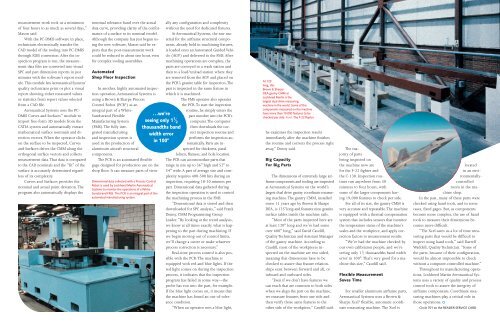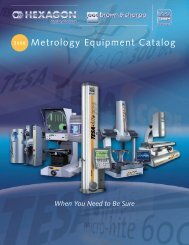shaping the future of metrology - Brown & Sharpe
shaping the future of metrology - Brown & Sharpe
shaping the future of metrology - Brown & Sharpe
Create successful ePaper yourself
Turn your PDF publications into a flip-book with our unique Google optimized e-Paper software.
measurement work took us a minimum<br />
<strong>of</strong> four hours to as much as several days,”<br />
Mason said.<br />
With <strong>the</strong> PC-DMIS s<strong>of</strong>tware in place,<br />
technicians electronically transfer <strong>the</strong><br />
CAD model <strong>of</strong> <strong>the</strong> tooling into PC-DMIS<br />
through IGES conversion. After <strong>the</strong> inspection<br />
program is run, <strong>the</strong> measurement<br />
data files are converted into visual<br />
SPC and part dimension reports in just<br />
minutes with <strong>the</strong> s<strong>of</strong>tware’s report module.<br />
This module lets Aeronautical Systems’<br />
quality technicians print or plot a visual<br />
report showing ei<strong>the</strong>r measured values<br />
or statistics from report values selected<br />
from a CAD file.<br />
Aeronautical Systems uses <strong>the</strong> PC-<br />
DMIS Curves and Surfaces module to<br />
import free-form 3D models from <strong>the</strong><br />
CATIA system and automatically extract<br />
ma<strong>the</strong>matical surface nominals and direction<br />
vectors.When <strong>the</strong> operator clicks<br />
on <strong>the</strong> surface to be inspected, Curves<br />
and Surfaces drives <strong>the</strong> CMM along <strong>the</strong><br />
orthogonal surface vectors and collects<br />
measurement data.That data is compared<br />
to <strong>the</strong> CAD nominals and <strong>the</strong> “fit” <strong>of</strong> <strong>the</strong><br />
surface is accurately determined regardless<br />
<strong>of</strong> its complexity.<br />
Curves and Surfaces provides <strong>the</strong><br />
nominal and actual point deviation.The<br />
program also automatically displays <strong>the</strong><br />
nominal tolerance band over <strong>the</strong> actual<br />
data curve, providing clarity <strong>of</strong> <strong>the</strong> conformance<br />
<strong>of</strong> a surface to its nominal model.<br />
Although <strong>the</strong> company has just begun using<br />
<strong>the</strong> new s<strong>of</strong>tware, Mason said he expects<br />
that <strong>the</strong> post-measurement work<br />
could be reduced to about one hour, even<br />
for complex tooling assemblies.<br />
Automated<br />
Shop Floor Inspection<br />
In ano<strong>the</strong>r, highly automated inspection<br />
operation, Aeronautical Systems is<br />
using a <strong>Brown</strong> & <strong>Sharpe</strong> Process<br />
Control Robot (PCR ® ) as an<br />
integral part <strong>of</strong> a White-<br />
Sundstrand Flexible<br />
Manufacturing System<br />
(FMS).The fully integrated<br />
manufacturing<br />
and inspection system is<br />
used in <strong>the</strong> production <strong>of</strong><br />
aluminum aircraft structural<br />
components.<br />
The PCR is an automated flexible<br />
gage designed for production use on <strong>the</strong><br />
shop floor. It can measure parts <strong>of</strong> virtu-<br />
Dimensional data collected with a Process Control<br />
Robot is used by Lockheed Martin Aeronautical<br />
Systems to monitor <strong>the</strong> operations <strong>of</strong> a White-<br />
Sundstrand FMS. The PCR is an integral part <strong>of</strong> this<br />
automated manufacturing system.<br />
…we’re<br />
seeing only 1 1 ⁄ 2<br />
thousandths band<br />
width error<br />
in 100"<br />
ally any configuration and complexity<br />
without <strong>the</strong> need for dedicated fixtures.<br />
At Aeronautical Systems, <strong>the</strong> raw material<br />
for <strong>the</strong> airframe structural components,<br />
already held in machining fixtures,<br />
is loaded onto an Automated Guided Vehicle<br />
(AGV) and delivered to <strong>the</strong> FMS. After<br />
machining operations are complete, <strong>the</strong><br />
parts are conveyed to a wash station and<br />
<strong>the</strong>n to a load/unload station where <strong>the</strong>y<br />
are removed from <strong>the</strong> AGV and placed on<br />
<strong>the</strong> PCR’s granite table for inspection.The<br />
part is inspected in <strong>the</strong> same fixture in<br />
which it is machined.<br />
The FMS operator also operates<br />
<strong>the</strong> PCR.To start <strong>the</strong> inspection<br />
routine, he simply enters <strong>the</strong><br />
part number into <strong>the</strong> PCR’s<br />
computer.The computer<br />
<strong>the</strong>n downloads <strong>the</strong> correct<br />
inspection routine and<br />
performs <strong>the</strong> inspection automatically.<br />
Parts are inspected<br />
for thickness, parallelism,<br />
flatness, and hole location.<br />
The PCR can accommodate parts that<br />
range in size up to 36" high and 52" to<br />
54" wide. A part <strong>of</strong> average size and complexity<br />
requires 400-500 hits during an<br />
inspection, requiring 18-20 minutes per<br />
part. Dimensional data ga<strong>the</strong>red during<br />
<strong>the</strong> inspection operation is used to control<br />
<strong>the</strong> machining process in <strong>the</strong> FMS.<br />
“Dimensional data is stored and <strong>the</strong>n<br />
downloaded for SPC analysis,” said Frank<br />
Denny, CMM Programming Group<br />
Leader. “By looking at <strong>the</strong> trend analysis,<br />
we know at all times exactly what is happening<br />
to <strong>the</strong> part during machining. If<br />
we begin moving out <strong>of</strong> control limits,<br />
we’ll change a cutter or make whatever<br />
process correction is necessary.”<br />
Real-time process control is also possible<br />
with <strong>the</strong> PCR.The machine is<br />
equipped with red and blue lights. If <strong>the</strong><br />
red light comes on during <strong>the</strong> inspection<br />
process, it indicates that <strong>the</strong> inspection<br />
program has failed in some way—<strong>the</strong><br />
probe has run into <strong>the</strong> part, for example.<br />
If <strong>the</strong> blue light comes on, it means that<br />
<strong>the</strong> machine has found an out-<strong>of</strong>-tolerance<br />
condition.<br />
“When an operator sees a blue light,<br />
At 125'<br />
long, this<br />
<strong>Brown</strong> & <strong>Sharpe</strong><br />
DEA gantry CMM at<br />
Lockheed Martin is <strong>the</strong><br />
largest dual drive measuring<br />
machine in <strong>the</strong> world. Some <strong>of</strong> <strong>the</strong><br />
components measured on <strong>the</strong> machine<br />
have more than 19,000 features to be<br />
checked per side. Inset: The F-22 Raptor.<br />
he examines <strong>the</strong> inspection results<br />
immediately after <strong>the</strong> machine finishes<br />
<strong>the</strong> routine and corrects <strong>the</strong> process right<br />
away,” Denny said.<br />
Big Capacity<br />
For Big Parts<br />
The dimensions <strong>of</strong> extremely large airframe<br />
components and tooling are inspected<br />
at Aeronautical Systems on <strong>the</strong> world’s<br />
largest dual drive gantry coordinate measuring<br />
machine.The gantry CMM, installed<br />
some 11 years ago by <strong>Brown</strong> & <strong>Sharpe</strong><br />
DEA, is 125' long and features nine granite<br />
surface tables inside <strong>the</strong> machine rails.<br />
“Most <strong>of</strong> <strong>the</strong> parts inspected here are<br />
at least 120" long and we’ve had some<br />
over 600" long,” said David Caudill,<br />
Quality Technician and Assistant Manager<br />
<strong>of</strong> <strong>the</strong> gantry machine. According to<br />
Caudill, most <strong>of</strong> <strong>the</strong> workpieces inspected<br />
on <strong>the</strong> machine are two sided,<br />
meaning that dimensions have to be<br />
checked to assure that feature relationships<br />
exist between forward and aft, or<br />
inboard and outboard sides.<br />
“Even if we don’t have features we<br />
can reach that are common to both sides<br />
when we align <strong>the</strong> part on <strong>the</strong> machine,<br />
we measure features from one side and<br />
<strong>the</strong>n verify those same features to <strong>the</strong><br />
o<strong>the</strong>r side <strong>of</strong> <strong>the</strong> workpiece,” Caudill said.<br />
The majority<br />
<strong>of</strong> parts<br />
being inspected on<br />
<strong>the</strong> machine now are<br />
for <strong>the</strong> F-22 fighter and<br />
<strong>the</strong> C-130. Inspection routines<br />
run anywhere from 30<br />
minutes to four hours, with<br />
some <strong>of</strong> <strong>the</strong> larger components having<br />
19,000 features to check per side.<br />
For all <strong>of</strong> its size, <strong>the</strong> gantry CMM is<br />
very accurate and repeatable.The machine<br />
is equipped with a <strong>the</strong>rmal compensation<br />
system that includes sensors that monitor<br />
<strong>the</strong> temperature status <strong>of</strong> <strong>the</strong> machine’s<br />
scales and <strong>the</strong> workpiece, and apply correction<br />
factors to measurement results.<br />
“We’ve had <strong>the</strong> machine checked by<br />
our own calibration people, and we’re<br />
seeing only 1 1 ⁄ 2 thousandths band width<br />
error in 100". That’s very good for a machine<br />
this size,” Caudill said.<br />
Flexible Measurement<br />
Saves Time<br />
For smaller aluminum airframe parts,<br />
Aeronautical Systems uses a <strong>Brown</strong> &<br />
<strong>Sharpe</strong> Xcel ® flexible, automatic coordinate<br />
measuring machine. The Xcel is<br />
located<br />
in an environmentallycontrolled<br />
room in <strong>the</strong> machine<br />
shop.<br />
In <strong>the</strong> past, many <strong>of</strong> <strong>the</strong>se parts were<br />
checked using hand tools, and in some<br />
cases, fixed gages. But, as components<br />
become more complex, <strong>the</strong> use <strong>of</strong> hand<br />
tools to measure <strong>the</strong>ir dimensions becomes<br />
more difficult.<br />
“The Xcel saves us a lot <strong>of</strong> time measuring<br />
parts that would be difficult to<br />
inspect using hand tools,” said Darrell<br />
Waddell, Quality Technician. “Some <strong>of</strong><br />
<strong>the</strong> parts, because <strong>of</strong> <strong>the</strong>ir configuration,<br />
would be almost impossible to check<br />
without a computer-controlled machine.”<br />
Throughout its manufacturing operations,<br />
Lockheed Martin Aeronautical Systems<br />
uses a variety <strong>of</strong> quality and process<br />
control tools to assure <strong>the</strong> integrity <strong>of</strong><br />
airframe components. Coordinate measuring<br />
machines play a critical role in<br />
those operations. o<br />
Circle 701 on <strong>the</strong> READER SERVICE CARD



